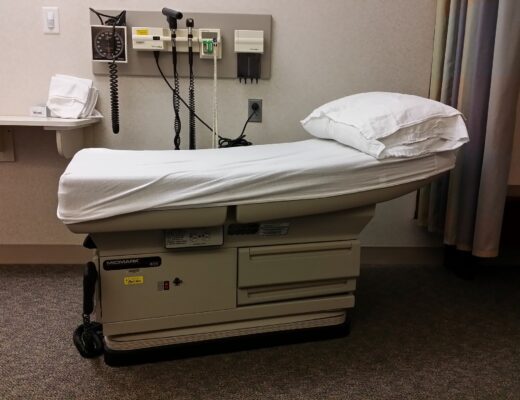One of the most rewarding things I do as an actor is participating in standardized patient work. I’m currently in the middle of a huge month-long exam with the medical students, so safe to say it’s been on my mind a lot.
So, briefly, a standardized patient is an actor who works with medical students. Or nursing, dental, vet, physician assistant students to give them a safe space to practice important skills. Such as listening, empathy, how to ask super awkward questions, build rapport, among other things, within a healthcare patient/doctor space.
I’ve got a whole post about how being a standardized patient transformed my acting you can check out here.
Now, what’s this whole ‘acting out the same moment 24 times in a day’ thing about?
If you haven’t guessed, it’s not about doing camera work.
Though keep reading, because it can be easily applied to camera stuff!
The MMI
MMI stands for Multiple Mini Interviews. In the medical school space, it’s used as a part of the larger application process for potential students.
It’s in some ways exactly how it sounds.
It’s usually a series of 10 stations, each about 7 minutes long.
Some stations are interviews with, say, the Dean or another faculty member for more of a classic interview. Another station may be team building and communication exercises with other candidates to see if the applicant plays well with others.
The third kind of station is where the actor comes in.
There’s a scenario on the door the applicant is about to walk into. It says, your co-worker is waiting for you, and together you have to get to the airport for a flight to a business conference.
Now, the actor is playing a character who has a fear of flying.
There are multiple kinds of actor scenarios, by the way. This is just the one I’ve done the most.
It’s the applicant’s job to engage in the scenario, to show their problem-solving skills as well as their ability to work with someone who is struggling.
They by no means have to ‘win’ and get the actor/co-worker to agree to get on the flight. But rather to establish rapport, buy into the scenario, and hopefully express some of their own vulnerabilities.
It’s a lot for the applicants. I mean, they’ve got at least 10 different scenarios they have to navigate through.
But, it’s also a lot for the actor.
Because, in this MMI process, they’ll be playing the same 7 minute scenario…roughly 24 times in one day. (Depending on how the interview is set up.)
Each one, guided by the applicant.
It’s kinda like acting for camera and doing take after take after take. But, with a different character opposite you, every single time.
Oh, and the other ‘actor’ doesn’t really wanna be doing the scenario.
There’s two main things I’ve learned by doing MMI’s. In a lot of ways, it’s great training specifically for camera work. But honestly, it really applies to all acting I’ve done.
It’s all about listening.
Actors who are great listeners tend to stand apart from those who don’t.
We all know (rather, I shouldn’t assume…) You may know what it’s like to work with an actor who’s only waiting for their cue or who can’t wait to talk themselves. Perhaps even steal the spotlight or simply don’t think your lines are important.
You may also know (hopefully!) what it’s like to work with a very giving scene partner who is hanging on your every word to react.
Which would you rather work with?
Working an MMI gig is a great lesson in being a good listening scene partner, as the focus is always on the applicant. As an SP, you don’t want to go rogue and assume everyone’s focus is on your performance.
Because it’s not.
Nothing is more embarrassing than having a very clear idea of how you think the scene is going and the applicant throws a curveball and you don’t even attempt to catch it.
I like to call this working with an unwilling scene partner. They may go off-script, stare at you blankly, begging for help with their eyes, or may not buy into the scenario at all.
It’s a great ‘stay in character’ test.
After all, if it’s a really awkward encounter, it only lasts 7 minutes.
Shake it off (thanks, Taylor Swift!)
Here comes the movement piece 🙂
I know, I know, you were starting to worry I wasn’t going to mention movement. This being a movement-specific blog and all. But, hey, the more general acting stuff is good too, right? 😉
Alright, now, regardless of how any individual encounter may go, you’ve gotta be able to start fresh with the next applicant.
New applicant=clean slate.
The last thing you want to do is have a carry-over of, say, you had a really nasty encounter. Would you agree that it wouldn’t be fair to the next applicant to have all those negative vibes thrown toward them?
So, as I’ve been saying, it’s like camera acting different takes but your scene partner changes each time.
And you’re NOT supposed to try new things as you normally would with multiple camera takes.
The goal is to present the same character and let the scene unfold with the applicant doing the guiding.
What I love to do between students, as I usually only have a minute (literally, everything is timed and runs like clockwork), is I stretch and shakes my arms (and my legs if it’s student #11 and I’m ready for lunch break…though I refrain from this is I have to pee.)
Shaking and stretching my body as gently or aggressively as I see fit (might change depending on the applicant that just finished) helps gets my nervous system back to a more neutral state. This is key for not only long acting days but portraying high-stress scenes. Like someone who’s afraid of flying, and is facing having to get on that plane, for example 🙂
Because let’s face it, once you get the hang of this, there’s still an element of nerves. You don’t know what’s about to walk through that door.
Plus, trust me, the applicant is BEYOND nervous, even if they don’t show it.
The applicant is always more neverous than you are.
So there you have it!
Now, you may never find yourself in an MMI situation as an actor, but you may find yourself having to go through the same scene time and time and time again.
No matter what, it’s always a good reminder to stay in the moment, shake it off between each take, and listen, listen, listen!
Also, if MMI or standardized patient work sounds intriguing to you, I’d highly recommend checking out your local medical, nursing, vet, and even law and enforcement schools. Many work with actors to flesh out the student’s experience to help them better serve their communities.




